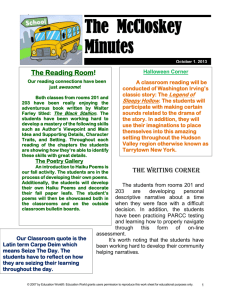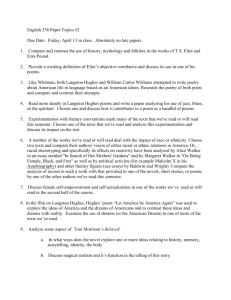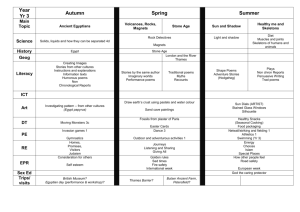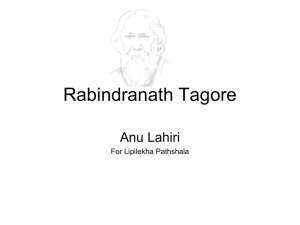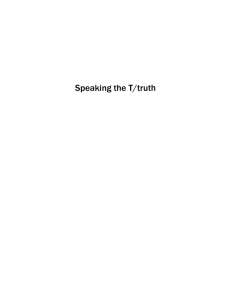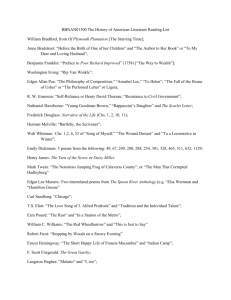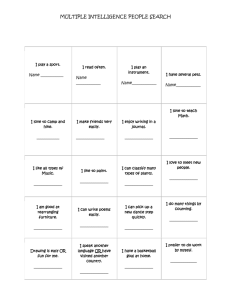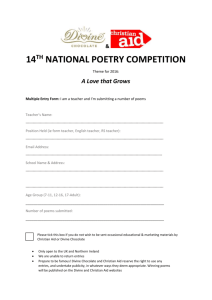Let`s Talk About It: Picturing America
advertisement
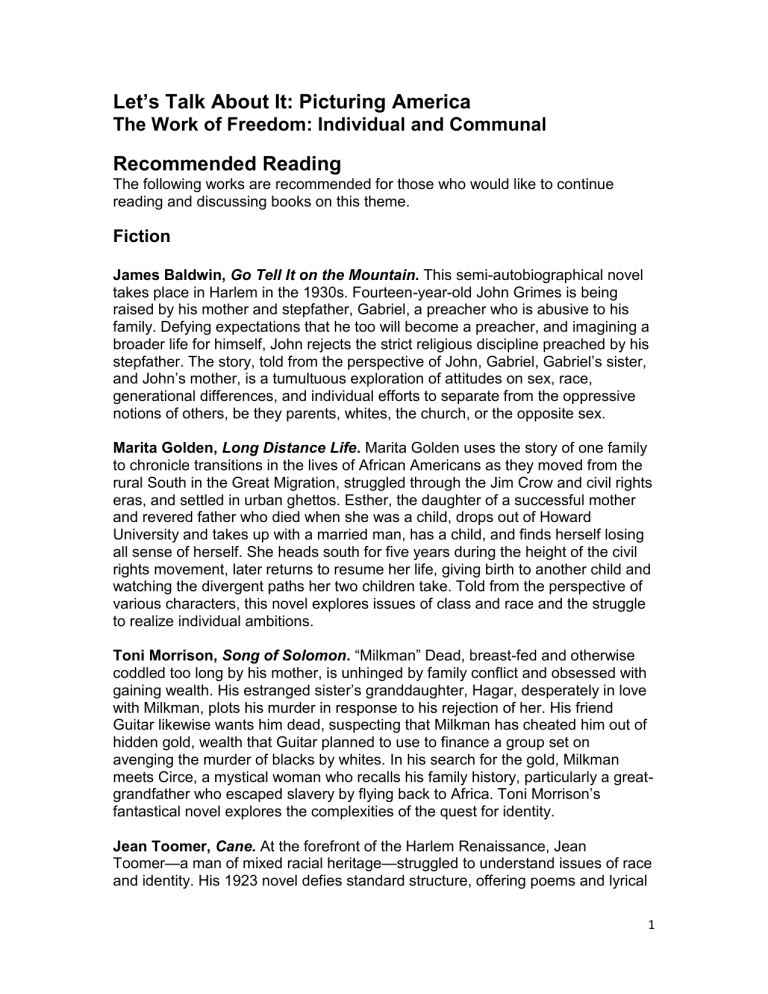
Let’s Talk About It: Picturing America The Work of Freedom: Individual and Communal Recommended Reading The following works are recommended for those who would like to continue reading and discussing books on this theme. Fiction James Baldwin, Go Tell It on the Mountain. This semi-autobiographical novel takes place in Harlem in the 1930s. Fourteen-year-old John Grimes is being raised by his mother and stepfather, Gabriel, a preacher who is abusive to his family. Defying expectations that he too will become a preacher, and imagining a broader life for himself, John rejects the strict religious discipline preached by his stepfather. The story, told from the perspective of John, Gabriel, Gabriel’s sister, and John’s mother, is a tumultuous exploration of attitudes on sex, race, generational differences, and individual efforts to separate from the oppressive notions of others, be they parents, whites, the church, or the opposite sex. Marita Golden, Long Distance Life. Marita Golden uses the story of one family to chronicle transitions in the lives of African Americans as they moved from the rural South in the Great Migration, struggled through the Jim Crow and civil rights eras, and settled in urban ghettos. Esther, the daughter of a successful mother and revered father who died when she was a child, drops out of Howard University and takes up with a married man, has a child, and finds herself losing all sense of herself. She heads south for five years during the height of the civil rights movement, later returns to resume her life, giving birth to another child and watching the divergent paths her two children take. Told from the perspective of various characters, this novel explores issues of class and race and the struggle to realize individual ambitions. Toni Morrison, Song of Solomon. “Milkman” Dead, breast-fed and otherwise coddled too long by his mother, is unhinged by family conflict and obsessed with gaining wealth. His estranged sister’s granddaughter, Hagar, desperately in love with Milkman, plots his murder in response to his rejection of her. His friend Guitar likewise wants him dead, suspecting that Milkman has cheated him out of hidden gold, wealth that Guitar planned to use to finance a group set on avenging the murder of blacks by whites. In his search for the gold, Milkman meets Circe, a mystical woman who recalls his family history, particularly a greatgrandfather who escaped slavery by flying back to Africa. Toni Morrison’s fantastical novel explores the complexities of the quest for identity. Jean Toomer, Cane. At the forefront of the Harlem Renaissance, Jean Toomer—a man of mixed racial heritage—struggled to understand issues of race and identity. His 1923 novel defies standard structure, offering poems and lyrical 1 prose, stories and vignettes to provide a unified impression of African American life and to explore broader themes of miscegenation, sexuality, and racial identity. The novel is organized into three sections, centering on life in rural Georgia, the black ghetto of Washington, D.C., and returning to rural Georgia. Among Toomer’s characters are Karintha, a disturbingly beautiful black woman, and Becky, a white woman who gives birth to two black sons in a small Southern town. Richard Wright, Uncle Tom’s Children. This was Richard Wright’s first published book (1938), and its very title suggests a break from past submissiveness and signals the beginning of modern black “protest” literature. Drawing on his own experience growing up in the Jim Crow South, as well as research he conducted as a journalist, Wright offers five stories, originally published independently. An adolescent is forced to flee the rural South to avoid his likely lynching after being in the wrong place at the wrong time; a conservative pastor finds it within himself to resist the blandishments of the white powers-that-be to lead a protest rally in a small Southern town; a woman absorbs a new vision of resistance given her by her sons as they work with the Communist Party. Poetry Gwendolyn Brooks, A Street in Bronzeville. Gwendolyn Brooks’s first book of poetry focuses on a racially segregated neighborhood in an unnamed city, patterned on Chicago’s South Side. Brooks celebrates the vitality of Bronzeville, the passion and promise of black folks who have fled the South for prospects up North; but she also offers a realistic portrait of their poverty and despair. Brooks captures the rhythm of city life among maids and hustlers, preachers and office workers, all crowded into a ghetto and making do with what little opportunity they have to live fully realized lives. Lucille Clifton, Good Woman: Poems and a Memoir, 1969-1980. Known for examining themes of gender and race consciousness, Lucille Clifton offers several of her published poems, including “Generations,” “Good News about the Earth,” and “An Ordinary Woman.” Her womanist perspective and ethnic pride mix with a spiritual consciousness rendered in lyrical mysticism. The book also includes her personal history, one of overcoming obstacles and discovering and expressing her creativity even as she came to know herself as daughter, wife, mother, and friend. Kwame Dawes, Wisteria. Ghanaian-born Jamaican poet Kwame Dawes carries the spirit of the diaspora in this collection of poems based on his friendships and conversations with elderly black women in the small town of Sumter, South Carolina. The women, all in their 70s and 80s, recall Jim Crow laws and sweet dreams of better lives for their children, along with recollections of everyday life 2 fortified by faith and hope. Dawes beautifully renders the voices of common people and conveys their impact on his sense of place and identity. Robert Hayden, Collected Poems. The first black poet chosen as consultant to the Library of Congress, Robert Hayden drew on extensive research he conducted while working for the Federal Writers’ Project for the historical basis of much of his work. The collection includes a series of poems on slavery and the Civil War and musings on historical figures from Frederick Douglass to Malcolm X. Hayden combined the historical and personal to offer a perspective on the longing for freedom from bondage and stereotype and all other encroachments on human expression. Langston Hughes, The Selected Poems of Langston Hughes. These poems are sharp-eyed, colorful portrayals of the daily life of African Americans rendered in the phrasings of colloquial language, songs of faith, soulful blues, and vibrant jazz. His poems are of trials and triumph, freedom and uplift, and the everyday rhythms of life’s joys and sorrows. The collection includes his best-known poems: “The Negro Speaks of Rivers,” “The Weary Blues,” and “Refugee in America.” Quraysh Ali Lansana, They Shall Run: Harriet Tubman Poems. Speaking mostly in the voice of Harriet Tubman, Quraysh Ali Lansana renders a songlike dialect that reflects on the steely determination of a woman who understands the compelling need for freedom. He also presents Tubman as a woman, less than heroic—the sum total of all the parts of every woman, complete with self-doubts and longings, but somehow assembled into heroic proportions. Marilyn Nelson, A Wreath for Emmett Till. Emmett Till was fourteen years old when he was murdered in 1955 in Mississippi for allegedly whistling at a white woman. His death sparked protests that fed the nascent civil rights movement. Marilyn Nelson explores Till’s life and the forces of racial hatred that led to his death. She touches on justice, innocence, and ghosts of “strange fruit.” Her poem is written as a “heroic crown of sonnets” —interlinking lines of poetry, with the last line comprised of the first line of each of the preceding 14 sonnets. This precise structure enables Nelson to protect herself emotionally as she struggles with this very painful subject. Sonia Sanchez, Shake Loose My Skin: New and Selected Poems. Published in 1999, this book brings together poems from earlier collections by Sonia Sanchez, including I’ve Been a Woman (1978), Homegirls and Handgrenades (1984), and Wounded in the House of a Friend (1995). Sanchez, one of the most powerful voices of the Black Arts Movement, brings boldness, strength, and energy to political awareness, as well as an inner emotional sense, as she explores racial identity, sexuality, and spirituality. Theater 3 W.E.B. DuBois/Thulani Davis, The Souls of Black Folks. In 2003, on the occasion of the 100th anniversary of the publication of W.E.B. DuBois’s The Souls of Black Folks, Thulani Davis staged dramatic readings from that famous work. DuBois offered the thematic frame for examining race in America through the “double consciousness” used by African Americans and the “veil” behind which emotions were hidden. His collection of essays, many in response to Booker T. Washington’s more moderate stance on the pace of racial progress, forcefully declared that “the problem of the Twentieth Century is the problem of the color-line.” In 1995, Davis participated in the documentary film W.E.B. DuBois: A Biography in Four Voices, along with Wesley Brown, Toni Bambara, and Amiri Baraka, describing significant periods in DuBois’ life. Endesha Ida Mae Holland, From the Mississippi Delta. Playwright Endesha Ida Mae Holland offers an autobiographical stage piece portraying the resilience of the female spirit. Three narrators tell the story of Phelia, a black girl raped at age eleven by her white employer who turns to prostitution and stealing until she finds redemption as a civil rights worker, and ultimately earns a doctoral degree. Phelia’s mother, Aint Baby, has her own triumphs, progressing from brothel madam to certified midwife. Samm-Art Williams, Home. Crossroads, North Carolina, in the late 1950s has little to offer the restless Cephus Miles. When his sweetheart, Pattie Mae, leaves for college and eventually marries someone else, he is humiliated and rendered directionless. He refuses to fight in Vietnam and serves time as a draft dodger. Later life in the big city offers a string of nowhere jobs. He loses the family farm until a mysterious benefactor rescues it. By the late 1970s, Cephus returns to witness huge changes in the town, the end of segregation, and new opportunities. But he continues to feel like an outsider, struggling with notions about the meaning of home. August Wilson, Joe Turner’s Come and Gone. The second work in August Wilson’s chronicle of the African American experience, this play is set in 1911 in a boardinghouse in Pittsburgh. Owner Seth Holly, his wife, Bertha, and their boarders talk about migration from the South, hopes of jobs in the North, disappointments of life, and the constraints of racism. A few of the boarders are haunted by memories of bondage and their fear of Joe Turner, a representational character who kidnapped freed and runaway slaves. The residents wrestle with searches for lost loved ones, and for a place for themselves in a changing world. Nonfiction Langston Hughes, “The Negro Artist and the Racial Mountain.” In this 1926 essay, written at the height of the Harlem Renaissance, Langston Hughes speaks to black intellectuals and artists, urging fearlessness in combining their art and their racial identity. He cites the frustrations of racial strictures but rails 4 against the temptation of artists to standardize themselves to white norms. Hughes urges artists to free themselves from constraints set by whites and distorted middle-class notions about the value and beauty of black culture. Amiri Baraka, Home: Social Essays. Amiri Baraka reprints essays he wrote in 1965 when he was still known as LeRoi Jones, offering a look back at the tumultuous 1960s. The collection begins with “Cuba Libre,” recalling a trip to Cuba on the first anniversary of Castro’s coup and Baraka’s exuberance at witnessing the successful outcome of a revolution and the promise of true reform. The collection moves on to angry and defiant essays about social injustices in the United States and sharp criticism of a consumer culture that ignores social inequities in favor of creature comforts. Let’s Talk About It: Picturing America is a project of the American Library Association Public Programs Office, developed with funding from the National Endowment for the Humanities and the Institute for Museum and Library Services. 5

